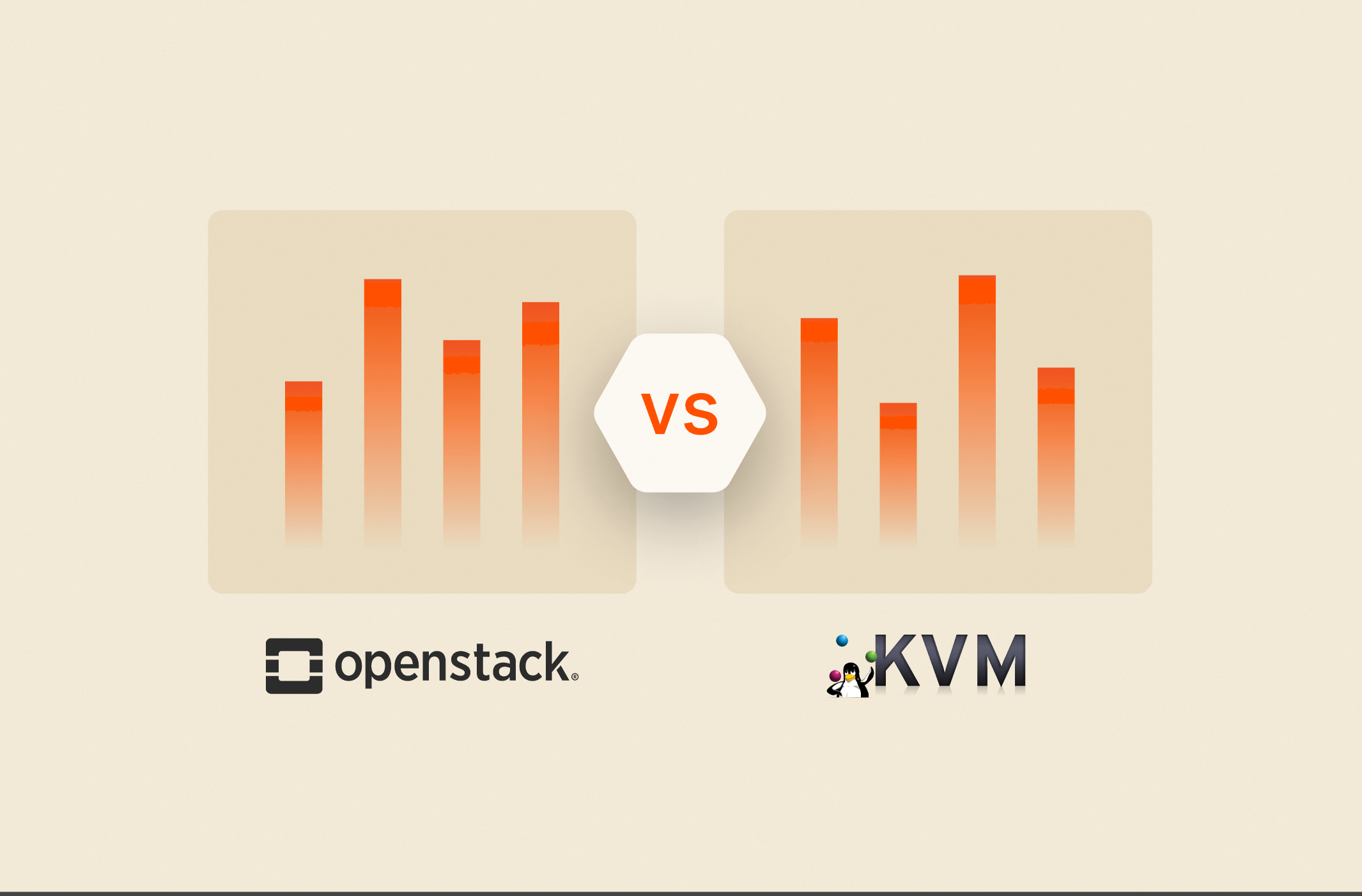Summary
OpenStack and KVM are open source virtualization solutions that are used for different purposes. While OpenStack is a comprehensive cloud platform, KVM provides a robust foundation for hosting virtual machines.
As organizations are increasingly turning to cloud and virtualization technologies to modernize their infrastructure, various technologies have sprung up to address this. Two of these technologies are OpenStack and Kernel-based Virtual Machine (KVM). Here, we will explore OpenStack vs. KVM.
Since choosing any technology can have business implications, IT professionals and decision makers must understand the nuances between OpenStack and KVM and how to optimize their cloud infrastructure.
While we’re comparing OpenStack and KVM, it’s important to note that they are not direct alternatives or competitors. In this comprehensive comparison, we’ll explore the difference between OpenStack, a full-stack infrastructure as a service (IaaS) platform and KVM, the underlying hypervisor that supports it. This comparison aims to clarify their roles, features, and use cases in modern IT infrastructures.
What Is OpenStack?
OpenStack is an open source cloud platform that empowers businesses to build and manage both public and private clouds. It provides a suite of services that work together to control large pools of compute, storage, and networking resources throughout a data center, enabling on-demand provisioning and management of cloud resources. It’s worth noting that OpenStack supports using KVM as its hypervisor, leveraging its capabilities to manage virtual machines efficiently.
Key aspects of OpenStack include:
- Modular architecture: OpenStack consists of several core components, including Nova (compute), Neutron (networking), and Cinder (block storage), among others. This modularity allows for flexible deployment and customization.
- Scalability: Designed to handle massive cloud infrastructures, OpenStack can manage thousands of nodes, making it ideal for enterprises and service providers.
- Versatility: OpenStack supports various workloads, including virtual machines, containers, and even bare-metal deployments.
- Community-driven innovation: Backed by a large and active community, OpenStack benefits from continuous innovation and robust support for diverse use cases.
Primary Use Cases of OpenStack
- Scalable cloud environments: It’s ideal for deploying and managing large-scale private or public clouds.
- Customizable infrastructure: Its modular nature allows for tailored cloud solutions.
- Hybrid cloud strategies: OpenStack seamlessly integrates with other cloud platforms, facilitating hybrid cloud implementations.
- Vendor independence: As an open source solution, OpenStack prevents vendor lock-in and offers full control over the cloud environment.
What Is KVM?
Kernel-based Virtual Machine (KVM) is a Linux-based open source hypervisor that transforms the Linux kernel into a bare-metal hypervisor. Unlike OpenStack, which is a comprehensive cloud platform, KVM focuses primarily on virtualization, providing a robust foundation for hosting virtual machines.
Key features of KVM include:
- Linux kernel integration: KVM is built directly into the Linux kernel, resulting in high efficiency and performance, especially in Linux-based environments.
- Wide OS support: KVM supports various guest operating systems, including Windows, Linux, and macOS, offering versatility in virtualization scenarios.
- Performance oriented: As a type-1 hypervisor, KVM delivers near-native performance for virtual machines, making it ideal for performance-critical environments.
- Security focus: KVM leverages Linux security features like SELinux and sVirt, ensuring robust VM isolation and protection.
Primary Use Cases of KVM
- High-performance virtualization: It’s ideal for environments where VM performance is crucial, such as data centers and compute-intensive applications.
- Cost-effective solution: Open source and lightweight, KVM offers efficient virtualization without hefty licensing fees.
- Linux environment optimization: KVM seamlessly integrates with Linux-based tools and services, making it perfect for Linux-centric infrastructures.
- Development and testing: It provides a flexible platform for creating and managing diverse virtual environments.
Key Differences between OpenStack and KVM
While both OpenStack and KVM serve virtualization needs, they differ significantly in scope and purpose. Understanding these differences is crucial for choosing the right solution for your environment.
| Aspect | OpenStack | KVM |
|---|---|---|
| Type | Full cloud management platform | Bare-metal hypervisor |
| Primary Use Case | Cloud infrastructure management | Virtualization of physical servers |
| Scope | Manages entire cloud environments | Manages individual server virtualization |
| Scalability | Highly scalable for large deployments | Scalable, but primarily for individual servers |
| Integration | Integrates with various cloud platforms and hypervisors | Integrates directly with the Linux kernel |
| Complexity | More complex, requires orchestration of multiple services | Simpler, focused on virtualization |
| Use in Infrastructure | Top-level management layer | Low-level virtualization layer |
Benefits of Using OpenStack
OpenStack’s comprehensive cloud management capabilities make it a popular choice for organizations building large-scale private and public clouds. Key benefits include:
- Unparalleled scalability: OpenStack excels in managing vast cloud environments, effortlessly scaling from a few VMs to thousands of nodes.
- Robust community support: As an open source platform, OpenStack benefits from a global community continuously developing new features, fixes, and integrations, ensuring its relevance and adaptability.
- Flexibility and customization: The modular architecture allows organizations to tailor their cloud environment, selecting only the necessary components and avoiding unnecessary overhead.
- Hybrid cloud readiness: OpenStack’s ability to integrate with other cloud platforms facilitates hybrid cloud strategies, enabling workload optimization across public and private clouds.
- Vendor independence: OpenStack’s open source nature prevents vendor lock-in, giving organizations complete control over their cloud infrastructure.
Benefits of Using KVM
KVM shines in environments where performance, security, and simplicity are paramount. Its key advantages include:
- High performance: KVM’s direct integration with the Linux kernel enables near-native performance, which is ideal for compute-intensive applications.
- Cost efficiency: As an open source solution with no licensing fees, KVM offers a cost-effective virtualization option without compromising on capabilities.
- Enhanced security: KVM leverages advanced Linux security features like SELinux and sVirt, providing robust VM isolation and protection against vulnerabilities.
- Simplicity and ease of use: Part of the Linux kernel, KVM requires minimal setup and configuration, making it an attractive option for teams seeking straightforward virtualization.
- Wide OS support: KVM’s ability to host various guest operating systems provides flexibility in diverse virtualization scenarios.
Use Cases: When to Choose OpenStack
OpenStack is the ideal choice for organizations focused on building or managing large-scale cloud environments. It’s particularly well-suited for:
- Large enterprises: Organizations managing complex cloud infrastructures with diverse workloads across VMs and containers
- Cloud service providers: Companies offering public or private cloud services can leverage OpenStack’s scalability and multi-tenancy features
- Research and academic institutions: Entities requiring flexible, scalable computing resources for data-intensive projects
- Telecommunications companies: Telecom providers modernizing their infrastructure for 5G and edge computing deployments
Use Cases: When to Choose KVM
KVM can be used independently or as part of an OpenStack deployment, depending on the specific needs of the organization. It’s particularly suitable for:
- Data centers: Facilities hosting multiple VMs with minimal overhead and maximum performance
- Development and testing environments: Teams needing quick provisioning of diverse virtual environments for software development and testing
- Small to medium enterprises (SMEs): Organizations seeking cost-effective virtualization without extensive cloud features
- High-performance computing (HPC): Environments requiring near-bare-metal performance for resource-intensive computations.
Conclusion
OpenStack and KVM are not mutually exclusive choices. Many organizations use both: KVM as the hypervisor layer and OpenStack as the cloud management platform. The decision isn’t always about choosing between them, but rather about determining whether you need the full cloud orchestration capabilities of OpenStack or if the virtualization features of KVM alone are sufficient for your needs.
When deciding, it’s crucial to consider your entire IT ecosystem, including storage infrastructure. Pure Storage offers a range of solutions that seamlessly integrate with both OpenStack and KVM environments. Whether you’re utilizing FlashArray™ for block and file storage or Portworx® for Kubernetes storage, Pure Storage’s cloud and on-premises solutions can help optimize your virtualization strategy.
To learn more about how Pure Storage can enhance your chosen virtualization solution, explore Pure Storage hybrid cloud solutions.

17 pages, Ebook
Data Virtualization Success Stories
Learn how these organizations have increased efficiency while reducing costs.
Simplify Your Journey
Learn more about hybrid cloud solutions from Pure Storage.
![]()






